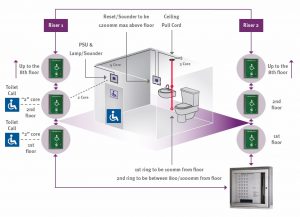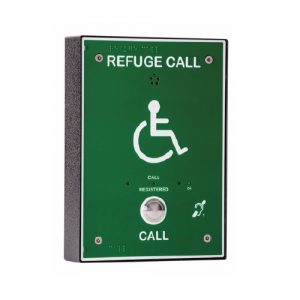Kentec Safe-Point Emergency Voice Communication System Now Available!
The Safety Centre are pleased to introduce the new Kentec Safe-Point Emergency Voice Communication System.
What is the Kentec Safe-Point Emergency Voice Communication System?
An EVC (Emergency Voice Communication) system (commonly known as a Disabled Refuge System) allows firefighters and staff to communicate, with persons awaiting safe evacuation in refuge areas, during emergency situations.
It enables people who seek assistance to have a constant two-way communication with emergency services from a number of points throughout a building or building complex, particularly in a fire emergency situation.
The Equality Act (2010) ensures that disabled people are treated equally, this includes responsibility on all businesses to ensure that everyone has access to buildings and services.
The provision of a safe refuge area enables the person who requires assistance to make their way to the closest designated area and await an evacuation.
There are certain standards that a safe area must adhere to. These are described in building regulations BS9999:2017, BS5839-9:2011 and BS8300:2009. All of these standards ensure that buildings are designed to meet the needs of disabled people.
Kentec Electronics Safe-Point EVC provides the communication from the safe refuge area to the emergency services.

What is a refuge area?
A refuge area can be defined as:-
- A safe place for disabled people to await evacuation assistance
- An enclosed area of fire-resisting construction
- Must be served directly by a safe route of exit
- Minimum size = 900mm x 1400mm – enough space for
a wheelchair to manoeuvre - Minimum of 30 minutes fire-resisting separation
- Wheelchair space should not reduce the width of escape route
- Wheelchair space must not obstruct flow of persons escaping
Which British Standards Concern Emergency Voice Communication Systems?
BS9999:2017 Code of practice for fire safety in the design, management and use of buildings.
Provides general recommendations and guidance for the design, management and use of buildings, ensuring effective fire protection for all people in and around buildings. It is applicable to new buildings and to alterations, extensions and changes of use of an existing building. Covers the entire life cycle of a building, using a risk assessment approach and risk profiles. It looks at means of escape and evacuation strategy, access and fire-fighting facilities, building structure including load and non-load bearing elements, guidance on voice alarms and special risk protection.
BS5839-9:2011: Fire detection and fire alarm systems for buildings – Code of practice for the design, installation, commissioning and maintenance of emergency voice communication systems
Provides recommendations for the design, installation and maintenance of emergency voice communication (EVC) systems as part of a fire safety strategy. This national standard applies to the use of EVC during an emergency fire situation at buildings, including sports stadiums, entertainment and other public venues. BS 5839-9 2011 emphasises correct use of an EVC in broadcasting evacuation messages and not in raising the fire alarm.
BS8300:2009:Design of buildings and their approaches to meet the needs of disabled people. Code of practice on accessible buildings
Provides recommendations for the design of new buildings and their approaches to meet the needs of disabled people. It lists a number of types of building it applies to but states that it does not apply to individual dwellings, residential buildings designed specifically for the needs of severely disabled people, or temporary structures. It mainly covers access to buildings, although reference is made to egress in event of fire or emergency the main recommendations for means of escape are given in BS9999. Although it is aimed specifically at the design of buildings to meet the needs of disabled people, its recommendations are also likely to benefit the population in general, e.g. elderly people, people with children in pushchairs and those carrying heavy luggage.
Kentec Safe-Point Emergency Voice Communication System Outstations

The Kentec Safe-Point Emergency Voice Communication System features both Type A (fire telephone) and Type B hands free type outstations. Either Type B can be used as a disabled refuge call point or a Fire Telephone. This is defined is BS5839 part 9. A call is made by pressing the large momentary push button. This will then illuminate the panel mounted ‘call registered’ red LED and initiate a conventional telephone call tone from the panel loudspeaker.
Click here to view the Kentec Safe-Point Emergency Voice Communication System range.
For more information on the Kentec Safe-Point Emergency Voice Communication System call us NOW on 01200 428 410, email on sales@thesafetycentre.co.uk or use the Livechat facility below.






